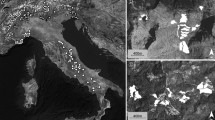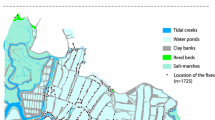Abstract
Habitat fragmentation seriously damages local biodiversity of widespread organisms, or so-called common species, in agricultural habitats. We hypothesized that specialists adaptive to local particular conditions makes a population of generalists vulnerable to habitat fragmentation. To evaluate the extinction-proneness of common rural species, we determined the extent of phenotypic divergence using paddy fish, medaka, Oryzias latipes. Despite its wide geographical range, a rapid population decline threatens its persistence, and remnants persist in fragmented patches. We studied niche profiling of populations from different habitats for a factor that possibly lies behind the species being abundant within particular areas. Measurements of behavioral and morphological characteristics provided comparable variables between populations. Principal component analysis summarized these variables into compounded elements relevant to foraging and predator avoidance. Detection of association between behavioral and morphological traits showed a limited number of phenotypes specific to a local habitat, through which individuals adapted to specific narrow niches. Medaka maintains its status by accumulating a variety of local specialists. Because of the limited-dispersal ability, specialized individuals are vulnerable to isolation in less suitable patches that are caused by the destruction of the habitat-network. From a conservation point of view, the results suggest that preservation of habitats that also serve as corridors is recommended for enhancing the richness of common species that are composed of adaptively diversified phenotypes.




Similar content being viewed by others
References
Albertson RC, Streelman JT, Kocher TD (2003) Genetic basis of adaptive shape differences in the cichlid head. J Hered 94:291–301
Angermeier PL (1995) Ecological attributes of extinction-prone species: loss of freshwater fishes in Virginia. Conserv Biol 9:43–58
Caughley G, Gunn A (1996) Conservation biology in theory and practice. Blackwell Science, Cambridge
Diamond JM (1975) The island dilemma: lessons of modern biogeographic studies for the design of natural reserves. Biol Conserv 7:129–146
Diamond JM (1984) “Normal” extinctions of isolated populations. In: Nitecki MH (eds). Extinctions. University of Chicago Press, Chicago
Eklöv P, Svanbäck R (2006) Predation risk influences adaptive morphological variation in fish populations. Am Nat 167:440–452
Fujioka M, Lane SJ (1997) The impact of changing irrigation practice in rice fields on frog populations of the Kanto Plain, central Japan. Ecol Res 12:101–108
Gaston KJ (1997) What is rarity? In: Kunin WE, Gaston KJ (eds) The biology of rarity. Chapman & Hall, London
Hayashi M (2003) Oryzias latipes. In: Ministry of Environment (eds) Threatened wildlife of Japan—red data book, vol 4. Pisces—brackish and freshwater fishes, 2nd edn. Japan Wildlife Research Center, Tokyo
Hidaka K (1998) Biodiversity conservation and environmentally regenerated farming system in rice paddy field. Jpn J Ecol 48:167–178
Hughes AL, Daily GC, Ehrich PR (1997) Population diversity: its extent and extinction. Science 278:689–692
Iguchi K, Yoshiba M, Wu W, Shimizu N (1999) Biodiversity of freshwater fishes in the paddy water systems of Anji, China. Bull Natl Res Inst Fish Sci 13:27–36
Iwamatsu T (1993) The biology of the medaka. Scientist-sha, Tokyo
Joshi J, Stoll P, Rusterholz H-P, Schmid B, Dolt C, Baur B (2006) Small-scale experimental habitat fragmentation reduces colonization rates in species-rich grasslands. Oecologia 148:144–152
Katano O, Hosoya K, Iguchi K, Yamaguchi M, Aonuma Y (2001) Comparison of fish fauna among three types of rice fields in the Chikuma River basin. Jpn J Ichthyol 48:19–25
Katano O, Hosoya K, Iguchi K, Yamaguchi M, Aonuma Y, Kitano S (2003) Species diversity and abundance of freshwater fishes in irrigation ditches around rice field. Environ Biol Fishes 66:107–121
Kiritani K (2000) Integrated biodiversity management in paddy fields: shift of paradigm from IPM toward IBM. Integr Pest Manag Rev 5:175–183
Kitano S (2005) Medaka representing rice paddy field. In: Katano O, Mori S (eds) Presence and future of endangered freshwater fishes in Japan—scenario to active conservation. Shinzan-sha, Tokyo
Madsen T, Stille B, Shine R (1996) Inbreeding depression in an isolated colony of adders, Vipera brevis. Biol Conserv 75:113–118
McEachern MB, Eagles-Smith CA, Efferson CF, Van Vuren DH (2006) Evidence for local specialization in a generalist mammalian herbivore, Neotoma fuscipes. Oikos 113:440–448
McKinney ML (1997a) How do rare species avoid extinction? A paleontological view. In: Kunin WE, Gaston KJ (eds) The biology of rarity. Chapman & Hall, London
McKinney ML (1997b) Extinction vulnerability and selectivity: combining ecological and paleontological views. Annu Rev Ecol Syst 28:495–516
Milano D, Ruzzante DE, Cussac VE, Macchi PJ, Ferriz RA, Barriga JP, Aigo JC, Lattuca ME, Walde SJ (2006) Latitudinal and ecological correlates of morphological variation in Galaxias platei (Pisces, Galaxiidae) in Patagonia. Biol J Linn Soc Lond 87:69–82
Ministry of the Environment (ed) (2003) Threatened wildlife of Japan—red data book, 2nd edn. Japan Wildlife Research Center, Tokyo
Morita K, Yamamoto S (2002) Effects of habitat fragmentation by damming on the persistence of stream-dwelling charr populations. Conserv Biol 16:1318–1323
Okitsu Y, Suguro N (2001) Fish fauna in Kuwahara–Oniyanagi channel with special reference to “Medaka”, Odawara, Kanagawa Prefecture. Nat Hist Rep Kanagawa 22:51–59
Pimm SL, Russel GJ, Gittleman JL, Brooks TM (1995) The future of biodiversity. Science 269:347–350
Sahara Y (2002) Alien species, Gambusia affinis. In: the Ecological Society of Japan (ed) Handbook of alien species in Japan. Chijinkan, Tokyo
Saitoh K, Katano O, Koizumi A (1988) Movement and spawning of several freshwater fishes in temporary waters around paddy fields. Jpn J Ecol 38:35–47
Sakaizumi M (1984) Rigid isolation between the northern population and the southern population of the medaka, Oryzias latipes. Zool Sci 1:795–800
Sakaizumi M, Moriwaki K, Egami N (1983) Allozymic variation and regional differentiation in wild populations of the fish Oryzias latipes. Copeia 1983:311–318
Simberloff D, Cox J (1987) Consequences and costs of conservation corridors. Conserv Biol 1:63–67
Svanbäck R, Eclöv P (2003) Morphology dependent foraging efficiency in perch: a trade-off for ecological specialization. Oikos 102:273–284
Takehana Y, Nagai N, Matsuda M, Tsuchiya K, Sakaizumi M (2003) Geographic variation and diversity of the cytochrome b gene in Japanese wild populations of medaka, Oryzias latipes. Zool Sci 20:1279–1291
Tanaka M (1999) Influence of different aquatic habitats on distribution and population density of Misgurnus anguillicaudatus in paddy fields. Jpn J Ichthyol 46:75–81
Van Valen L (1965) Morphological variation and width of the ecological niche. Am Nat 94:377–390
Williams P, Whitefield M, Biggs J, Bray S, Fox G, Nicolet P, Sear D (2003) Comparative biodiversity of rivers, streams, ditches and ponds in an agricultural landscape in Southern England. Biol Conserv 115:329–341
Acknowledgments
We thank Taiga Yodo for his help in collecting fish and Naoto Matsubara for providing the video-recording and digital photographs.
Author information
Authors and Affiliations
Corresponding author
Rights and permissions
About this article
Cite this article
Iguchi, K., Kitano, S. Local specialists among endangered populations of medaka, Oryzias latipes, harboring in fragmented patches. Environ Biol Fish 81, 267–276 (2008). https://doi.org/10.1007/s10641-007-9198-5
Received:
Accepted:
Published:
Issue Date:
DOI: https://doi.org/10.1007/s10641-007-9198-5




